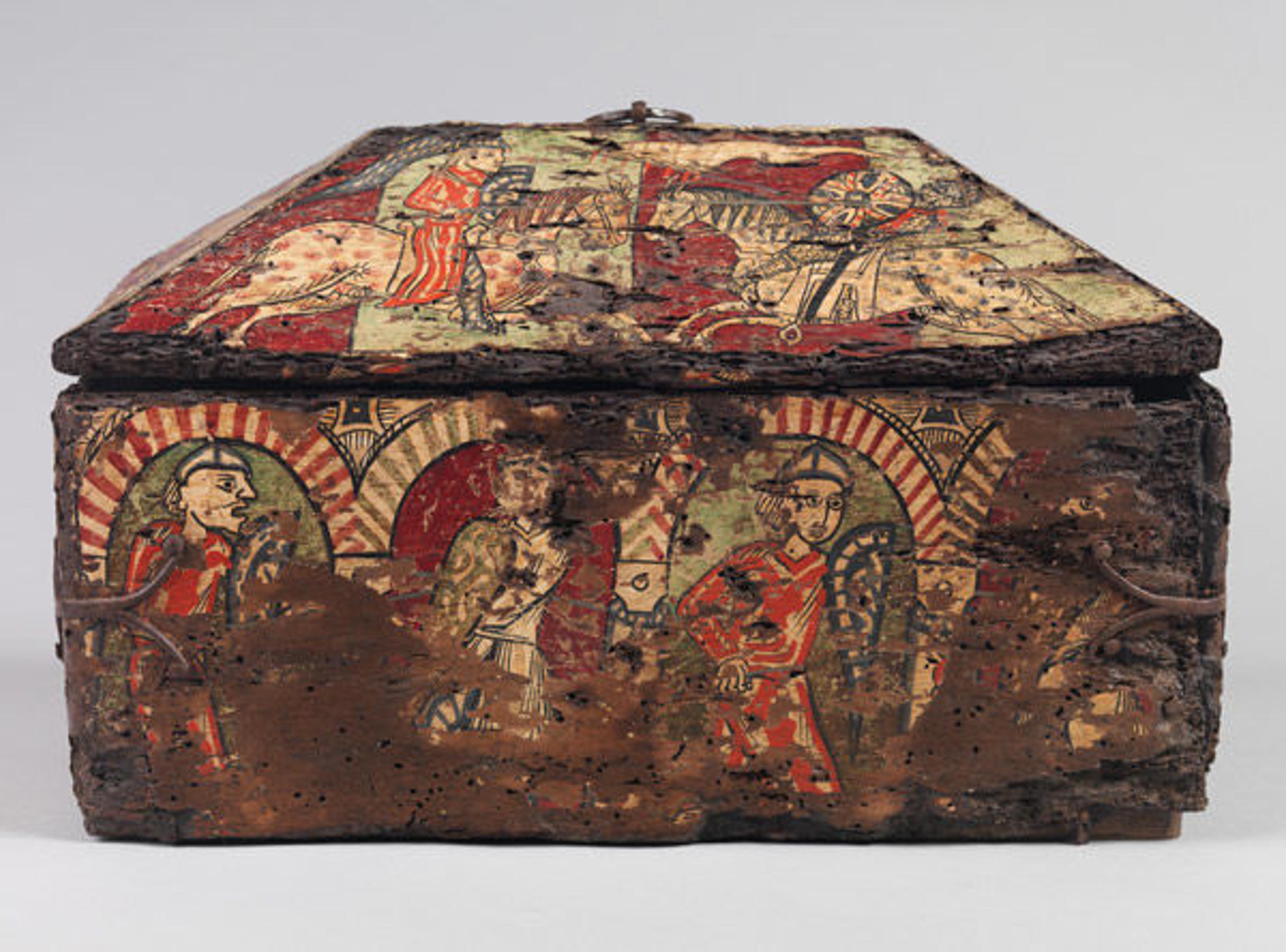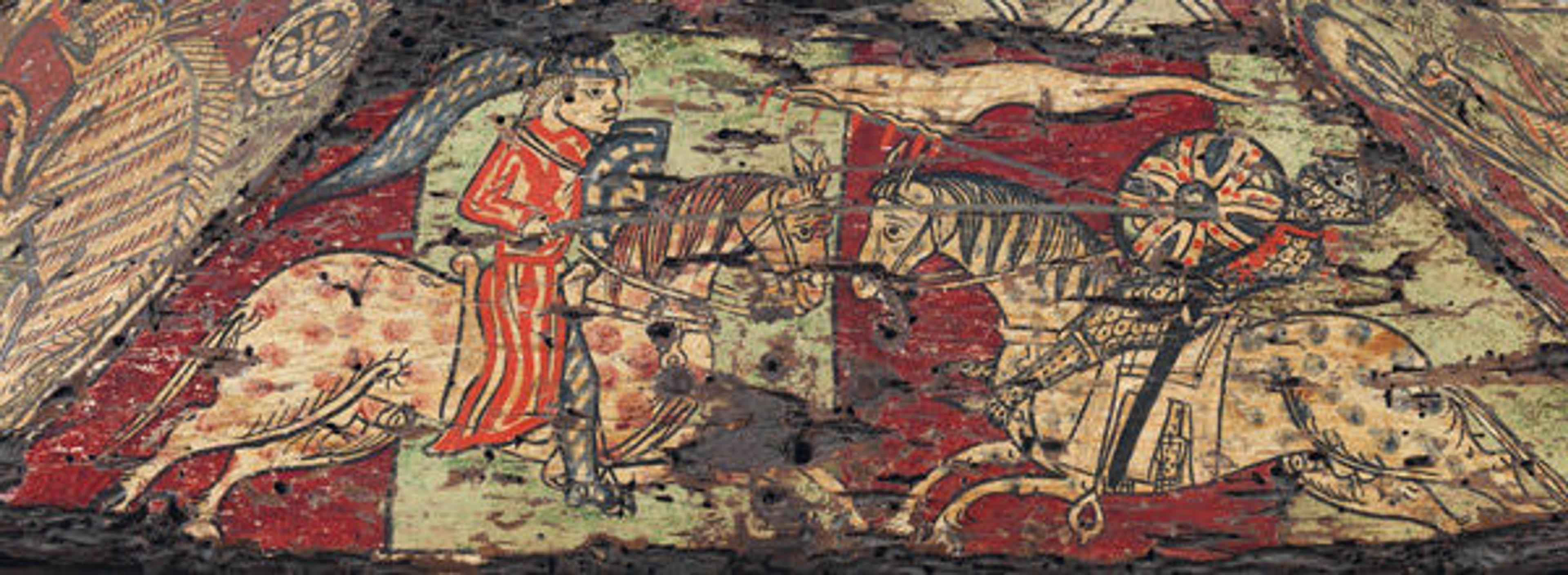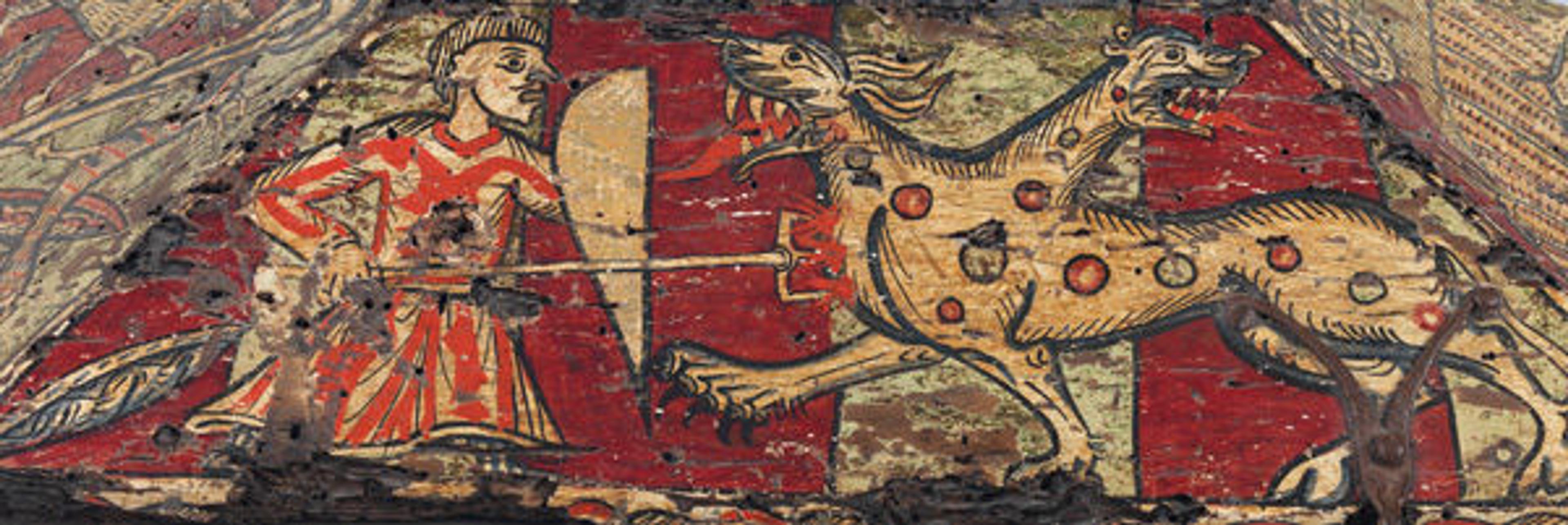Founding Father

Saint-Guilhem Cloister, late 12th–early 13th century. French. Limestone; 30 ft. 3 in. x 23 ft. 10 in. (922 x 726 cm). The Metropolitan Museum of Art, New York, The Cloisters Collection, 1925 (25.120.1–.134)
«At the heart of the Saint-Guilhem Cloister lies the heavily embroidered legend of the man who founded it—Saint William (Guilhem in the local Occitan dialect). A painted coffret on loan to The Cloisters depicts an early and colorful episode of his story; the stone cloister reflects the final, more sober chapter of the life of Guilhem.»

Painted wood box with the Legend of Guilhem of Orange, about 1200–1225. Southern France. Walnut, paint, and iron mounts. Private Collection, United Kingdom
Guilhem, a relative of Charlemagne, was a celebrated soldier and adventurer. His legend purports that the city of Orange in France had fallen under Muslim control (a historical inaccuracy) and that Guilhem was determined to retake it. His mission was fueled by Guilhem's passion for the famously beautiful Muslim queen Orable. To gain access to the palace of the "Saracens" (as Europeans then called Muslims), he disguised himself as a messenger in the service of their king.

Side view of the painted wood box with the Legend of Guilhem of Orange showing the tents of the Franks
After a lavish dinner, a game of chess, and a first meeting with the beloved queen, Guilhem's true identity was discovered, and he was thrown in prison. Guilhem's fellow Franks came quickly to his aid. They pitched their tents outside the gates of Orange and breached the city's defenses by traveling single file through the secret, subterranean passageways that the queen had informed them of. A pitched battle ensued, culminating in Guilhem's dramatic rescue.

Back panel of the painted wood box with the Legend of Guilhem of Orange showing Guilhem's fellow Franks traveling through the secret passageways
The text of the legend combines envy of the splendor and sophistication of the Muslim court with disturbing, unabashed anti-Muslim sentiment. However, I find more subtle and important themes manifest in the coffret, underpinning the history of our cloister.
On the coffret, vibrant reds bring the clashes of armies to life; there is confusion, even a sense of cacophony, but it is difficult to distinguish the Franks from the "Saracens." The helmets may be different, but beneath their protective headgear, the men are much the same. With splotches of orange paint, the artist makes it clear that war causes all men to bleed indiscriminately.

Front panel of the painted wood box with the Legend of Guilhem of Orange showing the battle between the Saracens and Guilhem and his Franks outside the gates of Orange
On the sloping lid of the back of the box, the Saracen Prince Aragon and Count Bertrand, a nephew of Guilhem, battle. The end is near: the Saracen reels from the blow and has lost his stirrup. But, importantly, the artist presents the men as worthy opponents, each astride a fine horse.

Detail of the sloping back lid of the painted wood box with the Legend of Guilhem of Orange showing the worthy opponents, Saracen Prince Aragon and Count Bertrand, in battle
On the opposite, front side of the lid, a knight stabs a two-headed beast. Does it represent an unrecognized chapter of Guilhem's legend? In purely visual terms, it conveys the savagery of battle.

Detail of the sloping back lid of the painted wood box with the Legend of Guilhem of Orange showing Guilhem stabbing a two-headed beast
The legend of Guilhem depicted on the coffret ends here, but the final chapters of his life story are key to the history of our cloister. Following his dramatic rescue at Orange, Guilhem, predictably, married the Muslim queen, had children, and fought more battles. Decades later and—according to the legend—after the death of his beloved wife, Guilhem unequivocally renounced his militaristic past, dramatically laying his shield on the altar of a church.
The legend tells us with both sensitivity and humor that adjustment to a new lifestyle was not easy. Determined to be a monk, Guilhem learned to read, but he struggled to tame his voracious appetite for food and drink. His fellow monks mocked him and conspired against the once mighty warrior. Ultimately, his better nature triumphed, and Guilhem lived out his days as a hermit in the dramatic rocky terrain beyond Montpellier.
There, says the legend: "Sir William the worthy intends to serve and honor almighty God for the sins which encumber his soul….In a few months he has [his dwelling] well repaired and enclosed and surrounded by a courtyard where he plants many trees and herbs." Today, the village that bears his name is a UNESCO World Heritage site.
We owe our cloister to the nobleman who embraced faith rather than fighting, the monastic life rather than the military. Surprisingly, the fame that followed proved to be greater. Even before Guilhem was recognized as a saint in 1066, the church in Saint-Guilhem-le-Désert became a celebrated destination for religious pilgrims, ultimately affording the monastic community sufficient wealth to create the beautifully carved cloister that is preserved, in large part, today in New York.

Another view of the beautifully carved Saint-Guilhem Cloister
For interested readers, a translation of La Prise d'Orange, the part of Guilhem's legend pictured on the coffret, and many more adventures can be found here.
As a final note, I find it astounding that, alongside the many legends about Guilhem, his actual last will and testament survives. Dated 28 January 804, it acknowledges his relatives and the worldly past he has relinquished. Unconventionally, the will names two living wives: Gunegunde and Guiborc. The latter is believed to be the Christian name taken by the beloved Muslim queen Orable.
Barbara Boehm
Barbara Drake Boehm is the Paul and Jill Ruddock Senior Curator for The Met Cloisters in the Department of Medieval Art and The Cloisters.